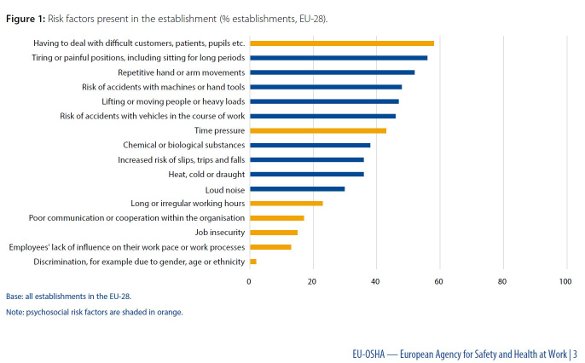The European Agency for Safety and Health at Work (EU-OSHA) published the results of ESENER-2 (Second European Survey of Enterprises on New and Emerging Risks), a Europe-wide survey of enterprises on OSH and workplace risks management. The survey is based on responses from nearly 50,000 companies from 36 countries and focuses on four areas of OSH:
- The general approach in the establishment to managing OSH.
- How the ‘emerging’ area of psychosocial risks is addressed.
- The main drivers and barriers to the management of OSH.
- How worker participation in OSH management is implemented in practice.
Dealing with difficult people is the greatest risk
The survey confirms that European workplaces are constantly evolving under the influence of changing economic and social conditions. For example, it reflects the continuing increase in the services sector. The most commonly identified risks are related to dealing with difficult customers, pupils or patients (58% of enterprises in the EU-28), followed by tiring or painful positions (56%) and repetitive hand or arm movements (52%). Psychosocial risk factors are considered to be more difficult to handle than others. Businesses often lack information or appropriate tools to deal with these risks effectively.
Risk assessments and measures to promote employee health
Seventy-six percent of enterprises in the EU-28 perform risk assessments regularly. As expected, there is a positive correlation with company size, when measured by country the values range from 94% of all enterprises in Italy and Slovenia to 37% enterprises in Luxembourg. Most of the companies surveyed which carry out regular risk assessments consider it a useful way of managing occupational safety and health (90%). Enterprises that do not perform regular risk assessments justify it by stating that the risks and hazards are already known (83%) and that there are no major problems (80%).
In 61% of enterprises, health and safety issues are regularly discussed at the top level of management, and the proportion increases according to the size of the enterprise. By country, this is reported most frequently in the Czech Republic (81%), the United Kingdom (79%) and Romania (75%). As far as the reasons that motivate enterprises to manage OSH, fulfilling the legal obligation is reported to be the main reason (85%). The second most important motivator is to meet the expectations of employees or their representatives.
All enterprises participating in ESENER-2 were also asked about how they promote health among employees. The most commonly cited measure (35% of enterprises in the EU-28) is raising awareness about preventing addiction (smoking, alcohol, drugs), raising awareness about nutrition (29%) and promoting sports activities outside working hours (28%). Measures for promoting health are most frequently reported by enterprises in the field of education, human health and social work activities.
The entire study is available for download from EU-OSHA website here or at www.esener.eu.
-kk-



